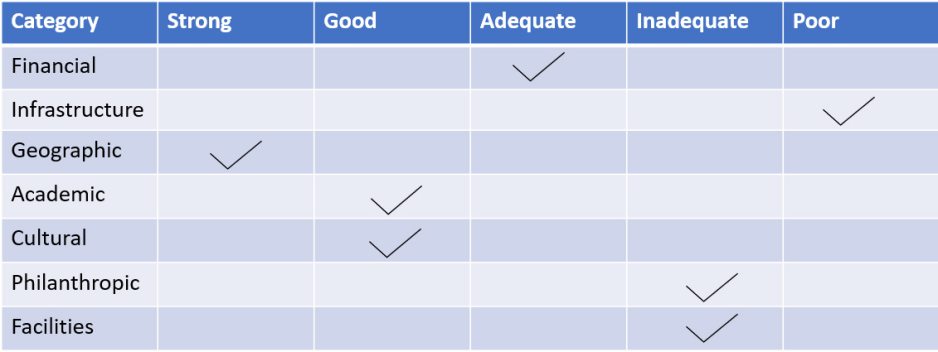
Sustaining Higher Ed is a monthly blog dedicated to helping college administrators and board trustees lead their organizations toward greater financial stability so they can stay on mission during challenging times.
“The essence of strategy is choosing what not to do,” said Michael Porter in his landmark essay, “What Is Strategy?” Successful strategy, Porter maintained, includes making trade-offs and setting limits. Institutions “that try to be all things to all customers…risk confusion in the trenches as employees attempt to make day-to-day operating decisions without a clear framework.”
In last month’s post, we described the many forces that are transforming higher education and heightening the urgency for higher ed leaders to assess the current state of their institutions and the strategic options available to them. That process begins with an assessment of the resources an institution has available and any constraints that those resources may place on an institution’s strategic options. If, as Porter insists, strategy requires choosing what not to do, this assessment will help define the choices that an institution can make, as well as those which it should not.
Kaufman Hall has long believed that strategic planning and financial planning activities must be highly interrelated and interdependent disciplines, in part to identify whether strategies can be supported financially, given the institution’s resource capacity. Integrated strategic financial planning, in other words, supports the work of making informed and realistic choices among strategic options, helps ensure that the choices made represent options that the institution can achieve, and establishes long-range financial and strategic goals to keep the institution on track.
The financial planning activities required for integrated strategic financial planning go far beyond a budget. They look out across a multiyear time horizon, project future financial performance, and incorporate several non-operating factors and asset and liability balance sheet factors that offer a fuller picture of an institution’s financial health. Factors considered in strategic financial planning also include potential advantages (or liabilities) in academic programs, institutional culture, geography, infrastructure, and facilities.
Consider the hypothetical case of a regional, mid-sized, private university located in the suburbs of a growing metropolitan region. The university’s enrollment of approximately 6,000 students is made up primarily of residential students pursuing a four-year undergraduate degree, with about 70% of students enrolled in the college of liberal arts and 30% enrolled in the college of business. Liberal arts and business faculty have developed a strong culture of collaboration and have created several interdisciplinary majors. Students enrolled in one school also can earn a minor at the other; the opportunity for liberal arts student to obtain a business school minor has helped stabilize enrollment in the college of liberal arts, and several departments have seen enrollment growth.
The university offers some master’s degrees, including an MBA, and has a law school located at a separate downtown campus. Undergraduate enrollment has held relatively steady, but the school has relied more heavily on tuition discounts to maintain enrollment in recent years. The law school, one of four in the state (and currently ranked third of the four), saw significant enrollment declines following the Great Recession in 2008-09 but has now stabilized at about 85% of peak enrollment in the early 2000s.
The university operates with a slim but positive operating margin overall; the margin has grown smaller as the university has relied more on tuition discounts and has carried a negative operating margin at the law school. Projections show that the university might move to a break-even or negative operating margin within the next three years; it currently maintains a low investment-grade credit rating, but the rating agencies have given the university a negative outlook. The university has postponed several major capital projects, including construction of a new student union and an upgrade to its athletic facilities, and its investment in new technology for both academic and administrative uses has lagged. It has an endowment of just under $100 million and has had a relatively steady yield from its annual fund over the past five years, but lackluster performance by its athletic teams has made fundraising more challenging.
A full assessment of the university’s performance across the categories outlined in the table below might generate the indicated results (presented here in simplified form).
Assessment Across Key University Categories

The university’s primary strengths include its location in a growing market with both suburban and downtown campuses, satisfactory outcomes from its academic programs, a proportion of faculty who are innovative, and a cohesive culture. Delayed investment in infrastructure and facilities are significant weaknesses, and it needs more robust philanthropic support to grow its endowment and fund needed capital campaigns. Its financial performance is adequate but on the edge, partially because its academic programs produce uneven and sometimes unknown financial results. If margins deteriorate over the next few years, its capacity and ability to take on debt to fund long-term investments will be constrained along with its ability to fully fund operating expenses.
As university leaders evaluate their strategic options within this framework, financial challenges will pose the most significant constraints on their choices: needed investments and the time required to begin realizing returns will be key considerations. The university has some assets that could be leveraged or monetized to support its strategic initiatives but doing so may require difficult choices about what programs and degrees the university will offer going forward.
In our next post, we will begin considering the strategic options available to the university and how an integrated strategic financial planning perspective helps guide what its leaders choose to do—and choose not to do.
We wish you all a happy holiday season and look forward to continuing our discussion in 2022. In the meantime, please reach out to us at lmielke@kaufmanhall.com or jwysocki@kaufmanhall.com with any comments or questions.









